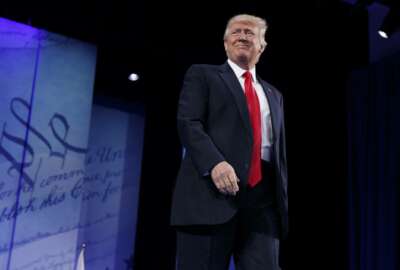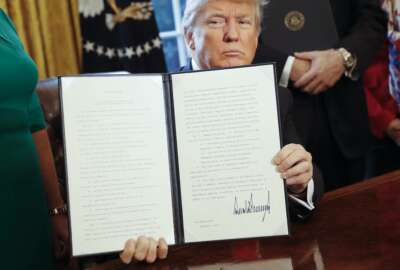
Congress seeks to codify Trump administration’s regulatory reform efforts
A new bill from Rep. Mark Meadows (R-N.C.) would make agencies' task forces and de-regulatory efforts permanent.
Subscribe to Federal Drive’s daily audio interviews on iTunes or PodcastOne.
Agencies have largely been enthusiastic about the Trump administration’s push to cut unnecessary regulations and create task forces to review costly, outdated or burdensome rules, at least according to some members of Congress who are overseeing the initiative.
But Congress likes what agencies are doing so much, some members want to make their work permanent.
“We have a remarkable opportunity here before us to modernize and streamline the federal government’s approach to regulation,” Rep. Gary Palmer (R-Ala.), chairman of the Intergovernmental Affairs Subcommittee, said Wednesday during a House Oversight and Government Reform Committee hearing on Environmental Protection Agency and the Energy and Interior departments’ plans to relieve regulatory burdens. “Mr. Jitinder Kohli, who led the United Kingdom’s one-in and two-out regulatory reform initiative, testified at our first hearing that this is fundamentally about culture change. It really is, and changing the culture of government, and I couldn’t agree more. Getting our government to take a fresh look at how it operates and changes its behavior is obviously no small task.”
A new bill from Rep. Mark Meadows (R-N.C.) would officially codify the Trump administration’s de-regulatory efforts, and it would arm agencies with the structures they need to continue that work well into the future. The Lessening Regulatory Costs and Establishing a Federal Regulatory Budget Act would also require agencies to designate an employee as the regulatory reform officer to head up the organization’s activities on the topic.
Agency heads must publish activities and actions from their regulatory reform task forces on a public website, according to the legislation. The site must list the members of the agency task force and publicize the agency’s regulatory reform reports.
In addition, the bill would direct the Office of Management and Budget Director to create a unified regulatory agenda and subsequent budget each year.
The House Oversight and Government Reform Committee will mark up Meadows’ legislation Thursday afternoon.
The bill appears to be in line with much of what many agency task forces are already doing, and members on the House Oversight and Government Reform Committee’s Intergovernment
Interior’s task force meets monthly to develop recommendations for repealing, replacing or changing agency regulations. The department has received about 215 public comments with suggestions for reducing DOI regulations.
The department removed 154 regulatory actions out of 321 proposed activities from its spring agenda, Interior Deputy Secretary David Bernhardt said. The agency took 13 de-regulatory actions in fiscal 2017 and has 28 more planned for 2018.
“There is a great deal of business process practices that probably can be reformed and shortened significantly,” he said. “You may have 40 [or] 50 people review a single document before it goes to the Federal Register. We’re looking at that to make that a more efficient and streamlined process itself.”
At EPA, the agency invited about 200,000 stakeholders to participate in 1,100 meetings and teleconferences on its regulations, and it issued a notice with a 30-day public comment period to solicit more feedback.
EPA received roughly 460,000 public comments — 63,000 of them were unique, individual ideas.
Meanwhile, the Energy Department solicited and received 132 public comments from trade associations, business groups and others.
The majority of members on Energy’s task force are agency career employees, said Daniel Simmons, acting assistant secretary for the department’s Office of Energy Efficiency and Renewable Energy. Those career staff members have provided “indispensable information,” he said, and they’re contributing to department’s push to develop more efficient and less-bureaucratic processes at national research laboratories.
“We want to make sure that … we strip out as much bureaucracy as we can,” Simmons said of Energy’s regulatory work with the national labs. “But the people who have to deal with that on a day-to-day basis and will deal with it in four years and eight years and 16 years, those are all career staff. They very much want the best process possible. That’s why, especially in that area, that their input has been so valuable to us.”
Energy, EPA and Interior all cited relatively positive relationships with career employees as they eliminate regulations and discuss other changes.
“[With] the establishment of the SES corps, they understand clearly that administrations come and change policy perspectives and that represents the will of the people, and they’re prepared to work with everybody,” Bernhardt said. “That’s generally been my experience.”
Senior executives at the Interior Department, however, have previously said they felt “left in the dark” about their agency’s plans to restructure and reorganize and said leadership hadn’t involved them in the decision-making.
Meanwhile, some members of Congress expressed concerns about agencies’ efforts to make their regulatory reform work transparent to the public.
The new legislation requires that agencies publicize their activities and list task force membership on a website, but not all agencies are taking that step.
EPA lists its task force members online, but Energy and Interior haven’t yet.
“I just think it’s important that in the process of the review that the task force is making, not only that the names of the members are there but the process in which regulations they’re reviewing are there for public comment as well,” Rep. Stacey Plaskett (D-V.I.) said.
Copyright © 2025 Federal News Network. All rights reserved. This website is not intended for users located within the European Economic Area.
Nicole Ogrysko is a reporter for Federal News Network focusing on the federal workforce and federal pay and benefits.
Follow @nogryskoWFED
Related Stories




